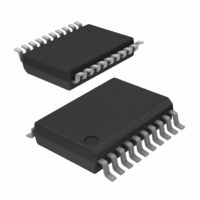SA620DK,118 NXP Semiconductors, SA620DK,118 Datasheet - Page 5

SA620DK,118
Manufacturer Part Number
SA620DK,118
Description
IC LNA MIXER VCO 1GHZ 20-SSOP
Manufacturer
NXP Semiconductors
Datasheet
1.SA620DK118.pdf
(15 pages)
Specifications of SA620DK,118
Package / Case
20-SSOP
Current - Supply
10.4mA
Frequency
800MHz ~ 1.2GHz
Gain
11.5dB
Noise Figure
1.3dB ~ 1.9dB
P1db
16dBm
Rf Type
Cordless Phones, UHF
Test Frequency
900MHz
Voltage - Supply
2.7V ~ 5.5V
Maximum Input Frequency
1200 MHz
Maximum Power Dissipation
980 mW
Mounting Style
SMD/SMT
Maximum Power Gain
4.5 dB
Operating Supply Voltage
3.3 V, 5 V
Maximum Operating Temperature
+ 85 C
Minimum Operating Temperature
- 40 C
Operating Temperature (min)
-40C
Operating Temperature (max)
85C
Operating Temperature Classification
Industrial
Lead Free Status / RoHS Status
Lead free / RoHS Compliant
Lead Free Status / RoHS Status
Lead free / RoHS Compliant, Lead free / RoHS Compliant
Other names
568-2373-2
935143730118
SA620DK-T
935143730118
SA620DK-T
Philips Semiconductors
CIRCUIT TECHNOLOGY
LNA
Impedance Match: Intrinsic return loss at the input and output ports
is 7dB and 9dB, respectively. With no external matching, the
associated LNA gain is 10dB and the noise figure is 1.4dB.
However, the return loss can be improved at 900MHz using
suggested L/C elements (Figure NO TAG) as the LNA is
unconditionally stable.
Noise Match: The LNA achieves 1.6dB noise figure at 900MHz
when S
increase the NF and S
Thru-Mode: A series switch can be activated to feed RF signals
from LNA input to output with an attenuator (S
result, the power handling is greatly improved and current
consumption is decreased by 3.2mA as well. However, if this mode
is not required, C23 and R6 can be deleted.
Temperature Compensation: The LNA has a built-in temperature
compensation scheme to reduce the gain drift to 0.003dB/ C from
–40 C to +85 C.
Supply Voltage Compensation: Unique circuitry provides gain
stabilization over wide supply voltage range. The gain changes no
more than 0.5dB when V
Mixer
Input Match: The mixer is configured for maximum gain and best
noise figure. The user needs to supply L/C elements to achieve this
performance.
Mixer Bypass: To optimize the IP3 of the mixer input, one must
adjust the value of C14 for the given board layout. The value
2004 Dec 14
V
1GHz low voltage LNA, mixer and VCO
V_CONTROL
CC
(0 to V
LNA IN
GND
11
CC
= -10dB. Further improvements in S
)
10 F
C4
100pF
C2
1.8pF
C6
100pF
10k
0.1 F
SMV 1204 - 099
Alpha Industries
R1
C1
C3
21
3.9pF
C5
.
2.7nH
CC
L3
535 mils
increases from 3V to 5V.
4.7nH
D1
0.1 F
C8
w = 15 mils
L = 260 mils
1 F
C23
2.7nH
10k
C7
3.3pF
R2
L2
L1
56nH
0.44 F/(V
21
11
VCO OUT
= –7.5dB). As a
Figure 3. A Complete LNA, Mixer and VCO
will slightly
C22
(50 )
10
1
2
3
4
5
6
7
8
9
CC
LNA ENABLE
SA620
LNA ENABLE
LNA GND
LNA IN
LNA GND
LNA GND
OSC GND
MIXER PD
OSC PD
OSC1
OSC2
–1)
100pF
V
R = 9k x (V
C9
CC
C10
100pF
535 mils
4.7nH
R6
5
MIXER BYPASS
CC
typically lies between 1 and 5pF. Once a value if selected, a fixed
capacitor can be used. Further improvements in mixer IP3 can be
achieved by inserting a resistive loss at the mixer input, at the
expense of system gain and noise figure.
Tracking Bandpass Filter: At the LO input port of the mixer there is
a second-order bandpass filter (approx. 50MHz bandwidth) which
will track the VCO center frequency. The result is the elimination of
low frequency noise injected into the mixer LO port without the need
for an external LO filter.
Power Down: The mixer can be disabled by connecting Pin 7 to
ground. If a Schottky diode is connected between Pin 1 (cathode)
and Pin 7 (anode), the LNA disable signal will control both LNA and
mixer simultaneously When the mixer is disabled, 3mA is saved.
Test Port: Resistor R5 can be substituted with an external test port
of 50 input impedance. Since R5 and MIXER OUT have the same
output power, the result is a direct power gain measurement.
VCO
Automatic Leveling Loop: An on-chip detector and loop amplifier
will adjust VCO bias current to regulate the VCO amplitude
regardless of the Q-factor (>10) of the resonator and varactor diode.
However, the real current reduction will not occur until the VCO
frequency falls below 500MHz. For a typical resonator the
steady-state current is 3mA at 800MHz.
Buffered VCO Output: The VCO OUT (Pin 11) signal can drive an
external prescaler directly (see also the Philips SA7025 low voltage,
fractional-N synthesizer). The extracted signal levels need to be
limited to –16dBm or less to maintain mixer IIP3.
MIXER GND
MIXER OUT
C21
0.1 F
– 1)
OSC GND
VCO OUT
LNA BIAS
LNA GND
MIXER IN
LNA OUT
V
Vcc
CC
22
100pF
C20
R3
20
19
18
17
16
15
14
13
12
11
(1k , 83MHz)
MIXER OUT
w = 15 mils
L = 260 mils
100pF
C19
w = 15 mils
L = 160 mils
1k
R4
C13
12pF
1000pF
C11
535 mils
5.6pF
4.7nH
C16
10pF
C14
1-5pF
150nH
C12
2.2pF
535 mils
L4
C18
4.7nH
100pF
C17
51
R5
LNA OUT
SA620
(50 , 83MHz)
MIXER IN
MIXER OUT
Product data
SR00116
0.1 F
C15
V
CC















